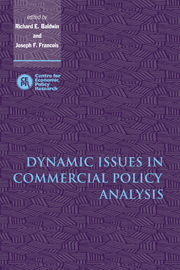Book contents
- Frontmatter
- Contents
- List of figures
- List of tables
- Preface
- List of conference participants
- 1 Introduction
- 2 Transition dynamics and trade policy reform in developing countries
- 3 Putting growth effects in computable equilibrium trade models
- 4 Innovation, capital accumulation, and economic transition
- 5 Multinational production, skilled labour, and real wages
- 6 Economic policy and the manufacturing base: hysteresis in location
- 7 Trade liberalization and investment in a multilateral framework
- 8 Investment creation and investment diversion: simulation analysis of the Single Market programme
- 9 Blueprints, spillovers, and the dynamic gains from trade liberalization in a small open economy
- 10 Trade policy and North–South migration
- 11 Long-term modelling of trade and environmental linkages
- 12 Labour markets and dynamic comparative advantage
- Index
9 - Blueprints, spillovers, and the dynamic gains from trade liberalization in a small open economy
Published online by Cambridge University Press: 13 January 2010
- Frontmatter
- Contents
- List of figures
- List of tables
- Preface
- List of conference participants
- 1 Introduction
- 2 Transition dynamics and trade policy reform in developing countries
- 3 Putting growth effects in computable equilibrium trade models
- 4 Innovation, capital accumulation, and economic transition
- 5 Multinational production, skilled labour, and real wages
- 6 Economic policy and the manufacturing base: hysteresis in location
- 7 Trade liberalization and investment in a multilateral framework
- 8 Investment creation and investment diversion: simulation analysis of the Single Market programme
- 9 Blueprints, spillovers, and the dynamic gains from trade liberalization in a small open economy
- 10 Trade policy and North–South migration
- 11 Long-term modelling of trade and environmental linkages
- 12 Labour markets and dynamic comparative advantage
- Index
Summary
Introduction
International trade economists have typically argued that an open trade regime is very important for economic development. This view has been based partly on neoclassical trade theory, which generally finds that a country improves its welfare from trade liberalization; partly on casual empirical observation that countries that remain highly protected for long periods of time appear to suffer significantly and perhaps cumulatively; and partly on systematic empirical work that also finds trade liberalization beneficial to welfare and growth (e.g. World Bank (1987) and Sachs and Warner (1995)). What has been troubling is that the numerical estimates of the impact of trade liberalization have generally found that trade liberalization increases the welfare of a country by only about 1 per cent of GDP, gains that are small in relation to the paradigm.
With the development of endogenous growth theory (for example, Romer (1990), Grossman and Helpman (1991), and Segerstrom et al. (1990)) a clear theoretical link has been provided from trade liberalization to economic growth. Owing to the complexity of the models, the theoretical literature has necessarily been based on rather aggregated models, and has focused on the steady-state growth path. In this paper we develop a dynamic numerical, which allows us to derive a number of interesting properties. One contribution of our paper relative to the theoretical literature is that we trace out the dynamic adjustment path of all the variables in the model and evaluate the welfare consequences of a change in policies; i.e. two policies that achieve the same steady-state growth path could have very different welfare consequences as a result of the dynamic adjustment path.
- Type
- Chapter
- Information
- Dynamic Issues in Commercial Policy Analysis , pp. 269 - 322Publisher: Cambridge University PressPrint publication year: 1999
- 2
- Cited by



